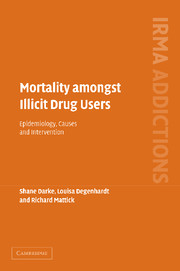21 results
Changes in mental health and help-seeking among young Australian adults during the COVID-19 pandemic: a prospective cohort study
-
- Journal:
- Psychological Medicine / Volume 53 / Issue 3 / February 2023
- Published online by Cambridge University Press:
- 10 May 2021, pp. 687-695
-
- Article
-
- You have access
- Open access
- HTML
- Export citation
Depressive symptoms during buprenorphine vs. methadone maintenance: findings from a randomised, controlled trial in opioid dependence
-
- Journal:
- European Psychiatry / Volume 19 / Issue 8 / December 2004
- Published online by Cambridge University Press:
- 16 April 2020, pp. 510-513
-
- Article
- Export citation
Addiction: From biology to drug policy, A. Goldstein, New York: W.H. Freeman and Co., 1994 ISBN 0-7167-2384-0, 321 pp. Price $41.95 Hardcover
-
- Journal:
- Behaviour Change / Volume 12 / Issue 1 / March 1995
- Published online by Cambridge University Press:
- 06 October 2014, p. 60
-
- Article
- Export citation
References
-
- Book:
- Mortality amongst Illicit Drug Users
- Published online:
- 30 September 2009
- Print publication:
- 21 September 2006, pp 145-186
-
- Chapter
- Export citation
Chapter 9 - Summary and conclusions
-
- Book:
- Mortality amongst Illicit Drug Users
- Published online:
- 30 September 2009
- Print publication:
- 21 September 2006, pp 135-144
-
- Chapter
- Export citation
List of tables
-
- Book:
- Mortality amongst Illicit Drug Users
- Published online:
- 30 September 2009
- Print publication:
- 21 September 2006, pp xi-xii
-
- Chapter
- Export citation
Chapter 8 - Reducing drug-related mortality
-
- Book:
- Mortality amongst Illicit Drug Users
- Published online:
- 30 September 2009
- Print publication:
- 21 September 2006, pp 111-134
-
- Chapter
- Export citation
Index
-
- Book:
- Mortality amongst Illicit Drug Users
- Published online:
- 30 September 2009
- Print publication:
- 21 September 2006, pp 187-191
-
- Chapter
- Export citation
Chapter 7 - Mortality and trauma
-
- Book:
- Mortality amongst Illicit Drug Users
- Published online:
- 30 September 2009
- Print publication:
- 21 September 2006, pp 96-110
-
- Chapter
- Export citation
Acknowledgements
-
- Book:
- Mortality amongst Illicit Drug Users
- Published online:
- 30 September 2009
- Print publication:
- 21 September 2006, pp ix-x
-
- Chapter
- Export citation
Chapter 5 - Illicit drug use and disease
-
- Book:
- Mortality amongst Illicit Drug Users
- Published online:
- 30 September 2009
- Print publication:
- 21 September 2006, pp 67-79
-
- Chapter
- Export citation
Frontmatter
-
- Book:
- Mortality amongst Illicit Drug Users
- Published online:
- 30 September 2009
- Print publication:
- 21 September 2006, pp i-iv
-
- Chapter
- Export citation
Chapter 2 - The global epidemiology of illicit drug use
-
- Book:
- Mortality amongst Illicit Drug Users
- Published online:
- 30 September 2009
- Print publication:
- 21 September 2006, pp 10-19
-
- Chapter
- Export citation
Chapter 3 - Mortality amongst illicit drug users
-
- Book:
- Mortality amongst Illicit Drug Users
- Published online:
- 30 September 2009
- Print publication:
- 21 September 2006, pp 20-41
-
- Chapter
- Export citation
Chapter 1 - Why illicit drug-related deaths matter
-
- Book:
- Mortality amongst Illicit Drug Users
- Published online:
- 30 September 2009
- Print publication:
- 21 September 2006, pp 1-9
-
- Chapter
- Export citation
Chapter 4 - Mortality and drug overdose
-
- Book:
- Mortality amongst Illicit Drug Users
- Published online:
- 30 September 2009
- Print publication:
- 21 September 2006, pp 42-66
-
- Chapter
- Export citation
Chapter 6 - Mortality and suicide
-
- Book:
- Mortality amongst Illicit Drug Users
- Published online:
- 30 September 2009
- Print publication:
- 21 September 2006, pp 80-95
-
- Chapter
- Export citation

Mortality amongst Illicit Drug Users
- Epidemiology, Causes and Intervention
-
- Published online:
- 30 September 2009
- Print publication:
- 21 September 2006
Contents
-
- Book:
- Mortality amongst Illicit Drug Users
- Published online:
- 30 September 2009
- Print publication:
- 21 September 2006, pp v-viii
-
- Chapter
- Export citation
Síntomas depresivos durante el mantenimiento con buprenorfina frente a metadona: hallazgos de un ensayo controlado distribuido al azar en la dependencia de opioides
-
- Journal:
- European Psychiatry (Ed.Española) / Volume 12 / Issue 3 / April 2005
- Published online by Cambridge University Press:
- 12 May 2020, pp. 185-191
- Print publication:
- April 2005
-
- Article
- Export citation



